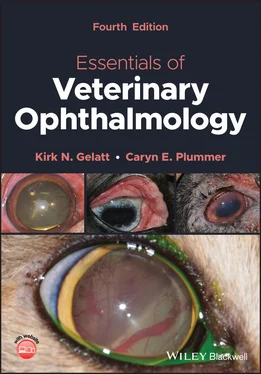At the same time, light also possesses the properties of particles, termed photons , which represent quanta of energy that can be emitted (at the light source) or absorbed (e.g., by retinal photoreceptors). The amount of energy in a given photon is inversely proportional to its wavelength; therefore, blue light possesses more energy than red light, which has a longer wavelength. An example of the particle nature of light is seen in the use of cobalt blue light to highlight fluorescein staining of corneal ulcers. Fluorescein sodium molecules absorb photons of blue light and reemit photons with lower energy content, in the yellow‐green portion of the spectrum, in a process known as fluorescence.
As light strikes the photoreceptor outer segments, it is absorbed by a visual photopigment. The function of this two‐part molecule reflects the principles of quantum physics, as it utilizes both the wave properties and the particle properties of light. The first part of the molecule, the opsin , determines the wavelength of the light that the photopigment will absorb, thus determining color vision. The second part of the molecule, the visual chromophore or retinal , uses the energy of the photon to undergo isomerization (from 11‐ cis ‐retinal into all‐ trans retinal in the case of rhodopsin), thereby initiating conversion of a light stimulus into an electric signal. This process, the phototransduction process , which is discussed in detail later in this chapter, is the first step in the propagation of a visual signal.
Photometry is the quantitative measurement of visible light. Photometry measures a number of interrelated properties of light, using a basic unit called a candela . Two important characteristics of light are its luminous intensity, which describes the intensity of a light source (as measured in candela), and its luminance, which describes its brightness reflected from a surface (as measured in foot‐lamberts or cd/m 2). These two properties are related, but they are not necessarily proportional. A handheld transilluminator is a bright source of light, but it possesses low intensity and therefore cannot be used to illuminate a football stadium. On the other hand, a streetlight provides high‐intensity light, which illuminates a large area, but it is not bright and does not provide enough illumination to conduct cataract surgery ( Table 2.12).
Table 2.12 Luminances of natural and artificial light sources. a
| Source |
Luminance (cd/m 2) |
| Sun |
10 9 |
| Car light |
10 7 |
| Incandescent tungsten lamp |
10 6–10 7 |
| Fluorescent lamp |
10 4–10 5 |
| Clear sky at noon |
10 4 |
| Full moon |
10 3 |
| Street lamp |
0.1–1.0 |
| Moonless night sky |
10 −3to 10 −6 |
aIn general, only the photopic system is active at a luminance >3 cd/m 2; at a luminance <0.03 cd/m 2, the scotopic system functions alone. Both systems are active at intermediate luminance values, which are defined as mesopic vision.
Luminance is measured using photometers, which are divided into two major classes. Visual photometers provide a subjective reading, because the observer compares the illumination of the measured light with that of a standard light. Photoelectric photometers convert the measured light into an electric current, which is displayed by the instrument. Photometry measurements are extremely important in electroretinographic (ERG) recordings because they are used to describe such variables as threshold, ambient light, and stimulus parameters.
Transmission and Reflection
Human vision is limited to a wavelength range of 380–780 nm. This limitation is a result of two factors: the first is the absorption spectrum of the opsin component of the visual photopigment, and the second limiting factor is the transmission, reflection, and attenuation of the various wavelengths by the ocular media.
In humans, radiation wavelengths of 300–2500 nm are transmitted through the cornea. Not all wavelengths, however, are transmitted through the cornea equally, as transmission is directly related to wavelength. In the rabbit, the cornea transmits 89–93% of the light at 370–500 nm, falling to 50% transmittance at 310 nm and a mere 2% at wavelengths below 290 nm.
Additional attenuation of transmission occurs inside the eye. Even though light with wavelengths of up to 2500 nm passes the cornea, there is barely any transmission of wavelengths greater than 1950 nm through the AH, and in humans, the lens only transmits wavelengths between 390 and 1400 nm. A similar range of wavelengths is transmitted through the pig eye. The implication of these numbers is that the aqueous and lens act as color filters, preventing UV and IR light with very short and very long wavelengths (which has passed the cornea) from reaching the retina. The UV filtering by the lens is of particular importance, as UV light is a risk factor in a number of retinal diseases. Therefore, the current IOLs are coated with UV filters to restore this protection in pseudophakic patients. In this context, it is noteworthy that aphakic humans can detect UV radiation following lens extraction, because the lens serves as a filter, blocking out light of shorter wavelengths. In other words, human opsin is capable of absorbing UV light, but these wavelengths do not reach the retina of phakic subjects.
Additional ocular structures, such as tear film and eyelids, also act as color filters, causing significant attenuation of short‐wavelength light. Thus, when cumulative transmittances are calculated for the successive components of the eye, a maximal transmittance rate in humans of 84% is obtained for light between 650 and 850 nm, while in rabbits the transmittance rate to light between 370 and 500 nm is 90%. Obviously, transmission will be further reduced by ocular opacities. Age is another factor affecting transmittance. Transmission of light at 480 nm through the human lens decreases by 72% from the age of 10 years to the age of 80 years, thus affecting color perception of the elderly.
Ocular surfaces can also reflect back incoming light, depending on the angle of incidence. Light that strikes a surface at an oblique angle is reflected back; it is not transmitted into the new medium. Most of the reflection that takes place in the eye occurs as incoming light strikes the cornea because of the large difference in refraction indices between the cornea and air. Reflection that occurs at the cornea–air interface affects not only incoming light but also outgoing light.
Light that is not transmitted and not reflected can be either scattered in the eye or absorbed by pigments. Foremost among these pigments are the photopigments of the photoreceptor outer segments, which absorb photons and thus initiate the visual process. Additional absorption processes in the eye may have clinical implications. Cyclophotocoagulation in glaucoma patients is based on the preferential absorbance of 810 and 1064 nm radiation of the diode and Nd:YAG lasers, respectively, by melanin‐containing tissues.
Geometric Optics
Refraction
In vacuum, light travels at a constant speed ( c ) of approximately 3 × 10 8m/s. As it strikes denser media, light undergoes three changes: (i) its velocity is reduced; (ii) its wavelength shortens; and lastly (iii) it is bent (unless it struck the surface of the medium at a 90° angle).
An object that bends (or refracts) light is called a lens. When a single ray of light strikes a lens, the ray undergoes simple refraction, as depicted in Figure 2.9. Most objects or images, however, generate a pencil of light rays rather than a single ray. When a pencil of rays strikes a lens, they spread apart (i.e., diverge) or come together (i.e., converge). Convergence, or positive vergence, occurs when light strikes a convex lens ( Figure 2.10a–c). Such a lens has a positive power, indicating that it forms a real image , which means that incoming rays from the object are converged and focused on the other side of the lens (see Figure 2.10a and b). On the other hand, divergence, or negative vergence, occurs when light strikes a concave lens (see Figure 2.10c). The negative power of the concave lens indicates that it forms a virtual or aerial image, which means that the diverging rays are traced, using imaginary extensions, backward to a “focused” virtual image “located” on the same side of the lens as the object (dashed, “imaginary” lines). The vergence power (i.e., amount of bending) of a lens is measured in units called diopters . One diopter (D) is the vergence power of a lens with a focal length ( f ) of 1 m when in air.
Читать дальше












